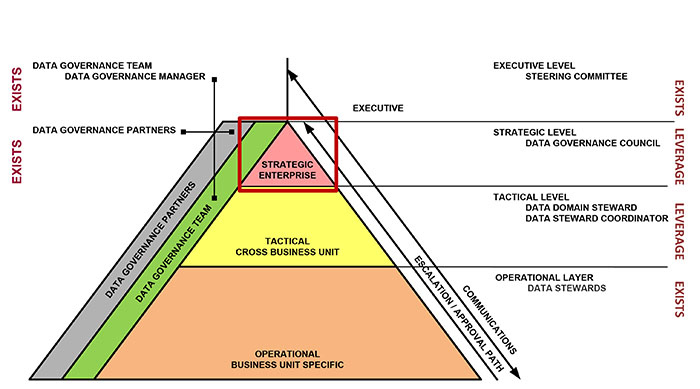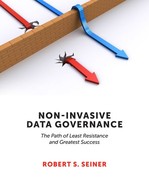|
|
Chapter 9 |
The strategic layer of the Operating Model of Roles & Responsibilities pyramid represents the Data Governance Council and the Executive Steering Committee.

Non-Invasive Operating Model of Roles & Responsibilities with Strategic Layer Highlighted
Strategic decisions need to be made when decisions can’t be made at the operational level (specific business unit) or the tactical level (first line of cross-business unit functionality) of accountability. Strategic decisions require that the people who make the decisions have the appropriate knowledge and documentation to help them to make the right decisions. This, in part, is what data governance is all about—sharing, recording and using knowledge about data.
A data-oriented strategic decision can be as major as the definition of a customer, as complex as the decision to use the coding scheme from system A or system B in the warehouse, or as involved as deciding which data profiling tool will best fit in your environment. These data-related decisions will have an impact across the organization and need to be made. Somebody (or some group) needs to be in a position to make these decisions. My suggestion, in line with many organizations defining a strategic level of data governance responsibility, is that this strategic group should be called the Data Governance Council.
Data Governance Council
Think of the group already used to define a strategic level of decision-making individuals in an organization. These individuals are asked to convene regularly to make decisions by representing their division, business unit, company, and so on. Could you leverage an existing group or replicate a group like that with data-savvy individuals who can understand the data governance program and step in to make decisions based on sufficient data knowledge?
Are Data Governance Council Members Supreme Beings?
The answer to this question is “yes” because council members serve as a kind of supreme court in matters of data governance. Typically, they are the end of the escalation line when it comes to making decisions.
We’ve already established that the decision-making buck stops with these individuals when it comes to strategic decisions made around the definition, production and usage of enterprise data. The fact that these people are at the strategic level implies that they may not be hands-on involved in day-to-day operations. Often, they’re only as informed about the daily definition, production, and usage of data as they want to be or have time for.
Some strategic thinkers are very hands on. Some are less so. This group is typically not involved in day-to-day operations of data governance because they have vice presidents in some cases, directors, mangers, supervisors, and so on, who work for them to handle those responsibilities.
In successful data governance programs I’ve been involved with, only a small percentage of data-related decisions, sometimes as few as one percent, get escalated through the operational and tactical ranks to reach the Data Governance Council. By the time the decision-making reaches these supreme beings, the knowledge about the issue—cause and effect, source(s), or threat, to name a few—should be recorded and prepared for presentation in a to-the-point manner. This is the responsibility of the group that administers the data governance program (the Data Governance Team in the pyramid diagram) as well as the operational and tactical stewards involved in decision activity.
Thrones and crowns are not required at the regular Data Governance Council meetings. Often the meeting attendees are brought together through technology. As often as needed, virtual meetings can be held when an issue requires attention and a regular meeting is not close. Timely communications with the Data Governance Council requires significant attention when rolling out a program.
Is the Data Governance Council the Top of the Data Food Chain?
The simple answer to this question is, “Yes.” The only level higher, the Executive Level (see the pyramid diagram), includes the sponsors and the senior-most management of the organization—the individuals who are typically far removed from daily operations and don’t have time to become involved in data-oriented decisions.
The Executive Level may set priorities and may squash projects and programs they don’t understand (Hint!), but the strategic-level decision-making often takes place at the next level down, at the level of the supreme beings or the Data Governance Council.
Why Do You Need a Council?
I’ve defined data governance earlier as “the execution and enforcement of authority over the management of data and data-related assets.” Of course, this definition can be, and has been, debated in several settings. Nonetheless, there needs to be a level of authority over how data is managed. Somebody has to be responsible and accountable for making the tough decisions where the enterprise is concerned.
This group should be formal and should include all necessary parts of the enterprise. This isn’t always the case. The Data Governance Council typically has representation from all areas of the business and technology. This council should be formal if its members will be expected to make strategic decisions that will impact business and technology areas. Organizations have attempted to leave the strategic decision-making to the data domain stewards at the tactical layer and have often found that these decisions need to be validated by a strategic council or committee.
This group may already exist in your organization without the data component, or with a completely different name. At a recent client, a university, the name of this group was the Administrative Systems Group. This implied IT, but it was not. Another recent client called this group the Data Council; another client called it the Technology Review Board, implying IT, and it was. Search for such a group before starting a new group.
Case Study: Identifying Data Governance Council Membership
The makeup of the Data Governance Council is often easy to describe—one person per division, business unit, or however you break your enterprise down at the highest level. At the university I just mentioned, five people on its council represented the five divisions of the university—Academic Affairs, Student Affairs, and so on.
At a bank, the divisions were Human Resources, Finance, Risk Management, and so on. At a manufacturer implementing SAP, the council comprised individuals who represented four companies that were pulled together in the same SAP instance. At a government organization the council is made up of divisional representatives.
Often, I suggest that each division provide a backup or an alternate representative who may or may not have voting (decision-making) capabilities for his or her division. When the representative can’t attend a meeting or become involved in a decision, the alternate has the responsibility for bringing the information forward to the council members.
How Much Time Should Council Members Spend on Data Governance?
This question of time varies for each organization. Typically, members of a Data Governance Council are asked to attend monthly or quarterly meeting of 60-90 minutes. I suggest that members allow another 60 minutes or so a month to review information shared with them by the resources implementing the data governance program. Often, their materials consist of items that have been, or will be, discussed in regular meetings. This part is easy to quantify, because members of the council can plan in their schedules and review at their convenience.
In the early phases of data governance program development and rollout, you may consider holding meetings with members of the Data Governance Council to explain the basis and drivers of the program, the key concepts, and best practices of the Non-Invasive Governance approach, the organization, the policy, and so on, so that they feel a part of the definition of the program. In some organizations, the Data Governance Council is asked to or required to approve those items just mentioned.
The difficulty of quantifying the amount of time becomes apparent when issues that are escalated to the council are being discussed and resolved. Often these issues are not resolved during the council meetings and are prioritized according to their importance to the organization. The time involved in resolving the issues can range from simply making a decision based on the information provided to them to forming working groups and committees to resolve more complex issues.
As a program matures, the Data Governance Council meets regularly with the individuals responsible for administering the program, who typically set the initial agenda. Often, the Data Governance Team Leader chairs meetings and actively engages all members of the council.
What Does the Data Governance Council Do?
The Data Governance Council includes these responsibilities:
- Become interested in data governance because you recognize shortcomings in the way your organization manages data.
- Become educated in what data governance means and how it can (and will) work for your organization.
- Become educated in what it means to embrace data governance and activate your organization’s data stewards.
- Approve items that need to be approved such as data policy, data role framework, methods, priorities, and tools.
- Push data governance into their areas by actively promoting improved data governance practices.
- Make decisions at a strategic level in a timely manner given the appropriate knowledge to make those decisions.
- Meet regularly (or send an alternate) and read minutes to stay informed of data governance program activities.
- Identify and approve pivotal data governance roles including cross-enterprise domain stewards and coordinators.
It can be problematic for the data governance program to overburden the Data Governance Council. As a client once told me, “These people have day jobs.” The idea of the Non-Invasive Data Governance approach is to get people doing the right thing around the management of data. Sometimes this involves strict authority. At other times, it is just, “I need to know the right thing to do.”
Consider leveraging your existing organizational structure to handle the responsibilities of the Data Governance Council. Also, consider limiting the number of issues that require the Data Governance Council’s decisions. This second point requires additional data governance structure that exists at the tactical level.
Executive Leadership Team
Much has been written about how to convince the highest level of an organization that a data governance program is necessary and how to gain management support, sponsorship, and understanding for and about it. I address the non-invasive approach for achieving this support in Chapter 1.
The Executive Level of the pyramid has no space inside the tower projecting from the top of the pyramid. Thus, this layer differs from the other three layers. Earlier, I had mentioned that data decisions are seldom escalated to the executive level of an organization. Typically, data decisions escalate to the strategic level designated or appointed by the executive level to represent their divisions in the highest level of data decision-making.
The top of the model, the Executive Layer consists of something that already exists in many organizations. That something is the executive level of management for the organization. This is the level we spelled out earlier that has to support, sponsor, and understand data governance and the activities of the program.

Non-Invasive Operating Model of Roles & Responsibilities with Executive Layer Highlighted
The executive layer of the operating model has no other specific function in the data governance program besides supporting, sponsoring, and understanding data governance. This section does not detail specific roles and responsibilities of the executive level because there are no responsibilities other than these three.
The data governance program will, however, risk failure if the executive level doesn’t support, sponsor, and understand data governance.
|
Key Points
|

